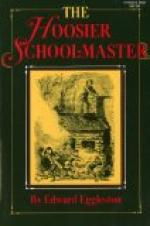Here he sat and shook with terror. Angry with himself, he inly denounced himself for a coward. But the effect was really a physical one. The chill and panic now were the reaction from the previous strain.
For when the sound of his pursuers’ voices broke upon his ears early in the evening, Ralph shook no more; the warm blood set back again toward the extremities, and his self-control returned when he needed it. He gathered some stones about him, as the only weapons of defense at hand. The mob was on the cliff above. But he thought that he heard footsteps in the bed of the creek below. If this were so, there could be no doubt that his hiding-place was suspected.
“O Hank!” shouted Bud from the top of the cliff to some one in the creek below, “be sure to look at the Spring-in-rock—I think he’s there.”
This hint was not lost on Ralph, who speedily changed his quarters by climbing up to a secluded, shelf-like ledge above the spring. He was none too soon, for Pete Jones and Hank Banta were soon looking all around the spring for him, while he held a twenty-pound stone over their heads ready to drop upon them in case they should think of looking on the ledge above.
When the crowd were gone Ralph knew that one road was open to him. He could follow down the creek to Clifty, and thence he might escape. But, traveling down to Clifty, he debated whether it was best to escape. To flee was to confess his guilt, to make himself an outlaw, to put an insurmountable barrier between himself and Hannah, whose terror-stricken and anxious face as she stood by the brook-willows haunted him now, and was an involuntary witness to her love.
Long before he reached Clifty his mind was made up not to flee another mile. He knocked at the door of Squire Underwood. But Squire Underwood was also a doctor, and had been called away. He knocked at the door of Squire Doolittle. But Squire Doolittle had gone to Lewisburg. He was about to give up all hope of being able to surrender himself to the law when he met Squire Hawkins, who had come over to Clifty to avoid responsibility for the ill-deeds of his neighbors which he was powerless to prevent.
“Is that you, Mr. Hartsook?”
“Yes, and I want you to arrest me and try me here in Clifty.”
FOOTNOTES:
[Footnote 26: I have already mentioned the absence of pail and pare from the ancient Hoosier folk-speech. Brook is likewise absent. The illiterate Indiana countryman before the Civil War, let us say, had no pails, pared no apples, husked no corn, crossed no brooks. The same is true, I believe, of the South generally. As the first settlers on the Southern coast entered the land by the rivers, each smaller stream was regarded as a branch of the larger one. A small stream was therefore called a branch. The word brook was probably lost in the first generation. But a small stream is often called a run in the Middle and Southern belt. Halliwell gives rundel as used with the same signification in England, and he gives ryn in the same sense from an old manuscript.]




